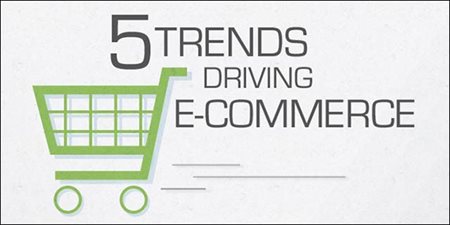What Makes or Breaks Ecommerce Revenue in 2018?
By Gabriella Pirrone
June 13, 2018
Amazon, Ann Handley, automation, chatbots, commerce, ecommerce, Elastic Path, E-mail Marketing, Hubspot, Instagram, marketing technologies, omnichannel, Shopify, social media, Video, voice assistants
Ecommerce is a really interesting topic for me and I feel as though it can be a never-ending discussion so today I’m going to do just that and discuss the top trends that are driving ecommerce sales in 2018.
Global ecommerce sales are expected to increase 246.15% by 2021, from 1.3 trillion in 2014 to 4.5 trillion in 2021 according to Statista.
 The ecommerce industry is booming and it’s showing no signs of slowing down. Nowadays, stores can’t compete without offering excellent ecommerce options, and 56% of in-store purchases are influenced by digital commerce. This means, if you aren’t reaching your customers online, you could be losing half of your potential revenue.
The ecommerce industry is booming and it’s showing no signs of slowing down. Nowadays, stores can’t compete without offering excellent ecommerce options, and 56% of in-store purchases are influenced by digital commerce. This means, if you aren’t reaching your customers online, you could be losing half of your potential revenue.
The trends below are in no particular order, but I’m diving into the ones that stand out most to me today and I think be seeing more of in the years to come.
Social Media Shopping
Social platforms are no doubt becoming virtual storefronts and as the saying goes ‘the proof is in the pudding’. According to Instagram, 80% of users say they follow at least one business on the app, with 60% hearing about a product and service through the platform. In 2017, over 120 million Instagram users visited a website, got directions, called a business, emailed or direct messaged a business.
At least 30% of Instagram users have purchased a product they first discovered on Instagram. If your business isn’t yet on a social media platform then these statistics will hopefully have you jump out of your seat and get started with opening an account!
But, this doesn’t just go for Instagram, Facebook also lends itself well with a unique opportunity for brands building and staying in front of users who scroll through their feeds daily. In 2018, we’ll see more retailers begin integrating social commerce software with their shopping platform and ensuring they use technology that caters to social scrollers.
Video and Media Search
My colleague Laura Myers wrote a very informative article on this topic and what video strategy can do for your business let alone just your marketing strategy. She mentioned “in a report from Hubspot research, video content was 43% more memorable for consumers than images at 36% and text at 18% so it only makes sense that video strategy with its higher engagement levels and impact on memory would be deployed in areas outside of just marketing.”
I also want to sneak this very important point into this topic, we need to be always thinking mobile first. In an official Google statement, more than 50% of search queries globally now come from mobile devices so if you aren’t mobile friendly, you probably aren’t garnering as many customers as you should be.
Chatbots and Automation
With 1.3 billion people on Facebook Messenger, it makes sense to take advantage of chatbots for marketing, customer service, and sales. With ecommerce, you can take it a step further.
I was fortunate to conduct an exclusive interview with Being digital commerce luminary, Darin Archer, CMO of Elastic Path about a month ago to gain his knowledge and expertise in the ecommerce space “I think this space is a really changing and having been a practitioner on the commerce side it really led the idea of putting a CMS in front of a commerce platform to empower marketers to start to own the shopping experience.”
He actually used Domino’s Messenger bot, Dom, as an example “You click the tongue and it orders the pizza” for full-menu ordering. The implications of this are huge: when fast and simple are priorities for consumers, there’s no doubt in my mind that Domino’s will beat out all the competition.
Chatbot ordering is a genius opportunity for Domino’s to cater to its audience in a fast new way, proving itself to be a helpful and forward-thinking company.
In 2017 alone, email generated more than 50 times its return on investment so email automation is not only important especially when it comes to automating your mailing lists for your online store but it’s especially important when trying to keep your audience engaged.
As I mentioned in one of my previous articles “companies that use email marketing automation to nurture their contacts see a 451% increase in qualified leads.”
Omnichannel
Today, using the term ‘Omnichannel’ often refers to “the overall brand experience that a customer has of you across any platform, any channel, in person or online – every step of the way.” As mentioned by Ann Handley, best-selling author, omnichannel marketing, and marketing specialist in a past article entitled 'Why Your Business Needs to Focus on Omnichannel Marketing’ discussing everything you need to know about omnichannel and technology to get maximum impact out of her marketing campaigns.
Omnichannel is a multi-channel sales approach that provides the customer with an integrated shopping experience. The customer can be shopping online from a desktop or mobile device, via phone, or in a brick-and-mortar store, and the experience will be seamless.
There was a recent study that found companies who adopted omnichannel customer engagement strategies actually retained 89% of their customers on average. Those businesses with weak omnichannel engagement retained just 33%.
AI and Voice Search
You are probably very familiar and very aware of Amazon Echo, Google Home, and other voice-activated devices. It’s said that these devices are growing in popularity and voice search will become the preferred method of search. According to Shopify, 40% of millennial’s are already using voice search before making an online purchase.
Voice search is actually 3x more likely to be local so it’s very important to ensure your business listing is updated on Google to reach those local searchers. For example, adding your business’ hours of operation, an up-to-date address, maybe even a few photos and perhaps a couple reviews will ensure your customers appreciation. I know I sure appreciate when I am searching for vital information such as closing hours for a particular business. Especially when everyone seems to be on a time crunch these days!
Ending Notes
It should come as no surprise that speed, convenience and accuracy define an optimal shopping experience. Customers increasingly value and appreciate the ability to buy items quickly and easily. In 2018 and into the coming year, new challenges will be posed by demand of next- and same-day delivery. Think of Amazon prime as an example, they have 100 million subscribers worldwide – why? Because they are convenient, they have excellent membership perks, they are easy-to-use and reliable.
I hope this article has helped shed some light on the latest trends and what to look out for when it comes to buying and selling online.

Gabriella Pirrone
Gabriella is the Digital Marketing Assistant for CMSC Media. She brings a wealth of knowledge from not only a CMS perspective but also content, SEO and eCommerce. She enjoys everything social media and staying ontop of the latest trends in the digital marketing world.